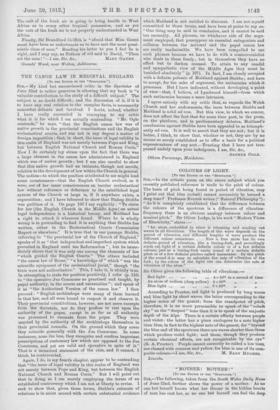COLOURS OF LIGHT.
[To THE EDITOR Or TER " STEOTATOR..] SIR,—In the artistic poem on the above subject which you recently published reference is made to the pitch of colour. The basis of pitch being found in period of vibration, may I point out that blue (cobalt) cannot accurately be termed a deep tone P Professor Everett writes (" Natural Philosophy ") : "As it is completely established that the difference between
the colours of the spectrum is a difference of vibration-
frequency there is an obvious analogy between colour and musical pitch." Sir Oliver Lodge, in his work " Modern Views of Electricity," states :— "An atom embedded in ether is vibrating and sending out waves in all directions. The length of the wave depends on the period of vibration, and different lengths of wave produce the different colour sensations. . . . Now a free atom has its own definite period of vibration, like a tuning-fork, and accordingly sends out light of a certain definite colour or of a few definite colours, just as a tuning-fork emits sound of a certain definite pitch or of a few definite pitches called harmonies. By the pitch of the sound it is easy to calculate the rate of vibration of the fork; by the colour of the light one can determine the rate of vibration of the atom."
Sir Oliver gives the following table of vibrations
Rod light ... ... 4 x 10 in a second of time An atom of sodium (deep yellow) fix 10" P.
Blue light ... ... 7 x 10" According to Proctor, red light is produced by long waves and blue light by short waves, the latter corresponding to the higher notes of the gamut; from the standpoint of pitch, therefore, it is no more permissible to speak of the "cobalt sky" as the "deepest" tone than it is to speak of the majestic
depth of the Alps. There is a certain affinity between purple and violet: the latter has a place analogous to a note higher than blue, in fact to the highest note of the gamut, for "beyond the blue end of the spectrum there are waves shorter than those which produce violet light; and these, though they produce certain chemical effects, are not recognizable by the eye" (R. A. Proctor). Purple cannot correctly be called a low tone, nor classed with crimson and yellow, for blue is one of its coin-
posits colours.—I am, Sir, &o., M. Elkin HUGHES., Lincoln. •






















































 Previous page
Previous page